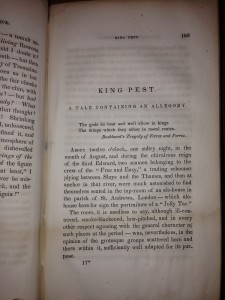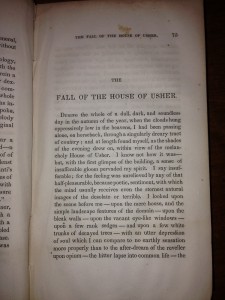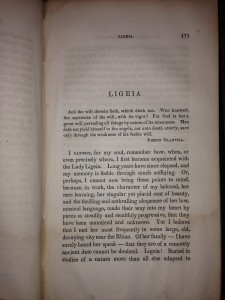Book Title: Tales of the Grotesque and Arabesque by Edgar A. Poe (1839)
I, like many other children in school, was required to read some of Edgar Allan Poe’s work. But why? Indeed, Poe is often (and was often) described by scholars and writers as a man of literary genius (Wagenknecht 6). But, if all it takes is the mark of a literary genius in order to cement oneself within the American education system, why was I not required to read some other author instead? Why read Poe? “Poe was an epileptic. Poe was a manic depressive. Poe was a necrophilliac. Poe was impotent. Poe was syphilitic. And so on, ad infinitum and ad nauseam” (Wagenknecht 13). Although Poe has often been labeled “as a solitary genius unconcerned with cultural contexts” (Faherty 4) due to his “imaginative writings” (Hayes xv), we, as Americans, read Poe because of quite the opposite. Poe was emblematic of American literary, political, and social trends during the 1830s, and this is why we, as Americans, study his work. A closer look into Tales of the Grotesque and Arabesque, a two-volume collection of many of his short stories, provides the reader with such a glimpse into American history.
Having access to one of the first editions of Tales of the Grotesque and Arabesque at the Special Collections & Archives room in Wake Forest’s Z. Smith Reynolds Library allows me the opportunity to truly experience the history surrounding Poe at the time of the book’s publication. For example, a plethora of praise and adoration from both critics and fellow writers at the time can be found at the beginning of the second volume of this edition. Not only is there praise for Poe’s skill as a writer, but also excitement over the compilation of many of his best tales into a two-volume book. For example, while referring to Poe’s “William Wilson,” Washington Irving states “that a series of articles of like style and merit would be extremely well received by the public” (qtd. in Poe I; vol. 2). Such a copious amount of adoration, in my opinion, helps to prove Poe’s ability to network and gain the support of a community of literary professionals. True, Poe’s “relations with other writers could be problematic” (Evelev 165); however, “Poe was trying to harness – rather than fight against – the mechanisms of the popular literary marketplace” (Evelev 161).For example, Poe frequently entered his work into literary contests in order to hopefully win and make a name for himself (Evelev 162). Poe’s “Manuscript in a Bottle,” a short story that can now be found in Tales of the Grotesque and Arabesque, was first published in a magazine as the winning entry for one of these competitions (Evelev 162). Albeit a winning title, “Manuscript in a bottle,” (as well as many of Poe’s other popular titles) never reached an extremely wide audience as a story published in a regional magazine. Poe needed more fame and, of course, more money. Tales of the Grotesque and Arabesque offered Poe a way to achieve this very goal. As an organized collection of short stories, Tales of the Grotesque and Arabesque allowed readers the chance to find and read many of Poe’s works easily. In addition, popular tales such as “The Fall of the House of Usher” would have no doubt helped to introduce many of Poe’s lesser known stories to more people because of their inclusion in Tales of the Grotesque and Arabesque. Indeed, Tales of the Grotesque and Arabesque was intended by Poe as a means to achieve success in the literary marketplace of the 1830s. Most likely, other authors at the time would have at least considered similar methods of increasing book sales and garnering attention. Poe’s example provides some insight into the past history of the American literary marketplace.
Tales of the Grotesque and Arabesque also provides a unique look into American politics and its relation to the literary world of America at the time of its publication. Although “Pinpointing Poe’s political affiliation has proven elusive” (Branam 209) for scholars, Poe was, by no means, politically apathetic. Duncan Faherty, in his “‘A Certain Unity of Design’: Edgar Allan Poe’s ‘Tales of the Grotesque and Arabesque’ and the Terrors of Jacksonian Democracy,” argues that the “certain unity of design” Poe writes of in his preface to Tales of the Grotesque and Arabesque is Poe’s exploration of the “dark side of Jacksonian social mobility, the terror resulting from an impassioned faith in self-determination” (5). Indeed, dark political themes are present in many of the stories found throughout Tales of the Grotesque and Arabesque – especially those that tackle the concept of change. “King Pest” is an obvious example. In this story, the characters “Legs and Tarpaulin trade community for never-ending chaos. In essence, they abandon a Jeffersonian world for a social order governed by a disturbingly different set of axioms that were Jacksonian in character” (Faherty 11). Roderick Usher, in “The Fall of the House of Usher,” states how he dreads “the events of the future, not in themselves, but in their results” (Poe 83; vol. 1 . Usher is expressing the fear that many Americans felt towards a rapidly changing political scene brought about by Andrew Jackson’s presidency. As a modern-day reader of Tales of the Grotesque and Arabesque, I cannot even pretend to truly understand the terror that a reader from the mid-19th century may have felt from such politically charged pieces of literary work. “King Pest” and other Anti-Democratic works by Poe may very well have been considered scandalous at the time and, as a result, may have garnered some amount of attention towards him and his work. Was this another way in which Poe thought to utilize the “mechanisms of the literary marketplace and mass-audience preferences” (Evelev 160) of America? Perhaps. What is certain, however, is that Tales of the Grotesque and Arabesque can provide the reader with a peek into American political history – an irresistible gold mine of educational opportunity for some high school English teachers .
Poe is most remembered today for his ability to craft extremely terrifying stories (I myself am afraid to one day find a beating heart beneath the floorboards of my apartment), so why did he choose to write about both the grotesque and the arabesque? What can be so horrifying about Near-East decorative design? Having read many novels, works of history, translated Oriental and Arabic literature, etc… that represented Eastern culture through a Western perspective (Montgomery 53), Poe would have had a very in-depth understanding of how Americans interacted with Arabic culture at the time. The arabesque was seen as mysterious and fascinating (Montgomery 54). Poe, understanding that people often fear what they do not truly understand, “[teases] out the latent terror quotient of the sublime image specifically through an abstracted Eastern figure (Berman 131). Instead of a harmonious pattern of flowing lines and shapes, Poe perverts the arabesque into a terrifying mass of writhing, squirming, and grotesquely animate set of forms. For example, “The phantasmagorical atmosphere in ‘Ligeia’ is especially cultivated through light effects brought about by the arabesque curtains and a huge censer” (Berman 144). Poe’s use of the arabesque not only demonstrates his ability to recognize and incorporate cultural currents into his writing, but also proves his point that “terror is not of Germany, but of the soul” (Poe 6; vol. 1). Any form of terror – no matter the cultural origin – has the potential to frighten the reader if executed properly. Poe’s use of the arabesque in his writing was his response to the popular methodology of invoking terror at the time. As a result of this, the reader learns of the increasing influence that the exotic had on American culture during the 1830s.
“The Fall of the House of Usher,” “William Wilson,” and many of the other tales featured in the Tales of the Grotesque and Arabesque can very well be considered works of great literary talent and should be reason enough for many to read Tales of the Grotesque and Arabesque. However, the history of the book itself should be considered as another reason for one to invest the time to explore the contents of the Tales of the Grotesque and Arabesque. Indeed, one can discover quite an in-depth look at American history through a thorough analysis of the history surrounding this book and its contents.
Works Cited
Berman, Jacob Rama. “Domestic terror and Poe’s Arabesque Interior.” ESC: English Studies in Canada. 31.1 (2005): 128-150. Muse. Web. 25 May. 2015.
Branam, Amy. “The Politics of Publishing.” Edgar Allan Poe in Context. Ed. Kevin J. Hayes. New York: Cambridge University Press, 2013. 209-217. Print.
Evelev, John. “The Literary Profession.” Edgar Allan Poe in Context. Ed. Kevin J. Hayes. New York: Cambridge University Press, 2013. 159-168. Print.
Faherty, Duncan. “‘A Certain Unity of Design’: Edgar Allan Poe’s ‘Tales of the Grotesque and Arabesque’ and the Terrors of Jacksonian Democracy.” The Edgar Allan Poe Review. 6.2 (2005): 4-21. JSTOR. Web. 25 May. 2015.
Hayes, Kevin J. “Preface.” Edgar Allan Poe in Context. Ed. Kevin J. Hayes New York: Cambridge University Press, 2013. xv-xviii. Print.
Montgomery, Travis. “The Near East.” Edgar Allan Poe in Context. Ed. Kevin J. Hayes. New York: Cambridge University Press, 2013. 53-62. Print.
Poe, Edgar Allan. Tales of the Grotesque and Arabesque. Philadelphia: Lea and Blanchard, 1840. Print.
Wagenknecht, Edward. Edgar Allan Poe: The Man Behind the Legend. New York: Oxford University Press, 1963. Print.




